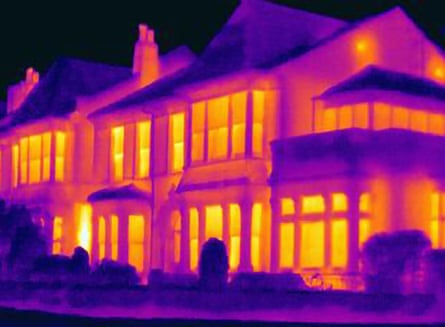To really get to grips with where your home is needlessly costing you energy a thermal imaging camera is a great tool: it shows up exactly where the hotspots for heat loss are, in multicolour.
In some parts of Britain it is possible to borrow one for free so you can find where to target your energy-saving efforts without any upfront cost.
Transition towns – communities that are working to promote sustainability and cut emissions – often have a camera loan scheme for local people. Bear in mind that most of these projects are very small scale and rely on volunteers: if you want to borrow one on demand you will need to go for a commercial hire company.
To use a thermal imaging camera effectively you need about a 10-degree difference between the temperatures indoors and outdoors, so the schemes typically operate only through the winter months.
Sustainable St Albans is one group that runs a loan scheme – it’s been doing so since 2014 during which time several hundred locals have used it. Residents need to sign up for a training session before they can take a camera home, with the next one set to take place in the autumn. (People who are interested can sign up to a monthly email newsletter where they will see details at the time.)
St Albans residents who have borrowed the cameras have reported being surprised by what they saw, with one saying there was “a lot more heat loss than envisaged”, and another saying “even drawing the curtains made a difference”.

Transition Bath also has a camera that people can borrow after training – Philip Haile from the group says this is because cameras can provide false positives, which users need to be careful to avoid. “Typically the camera is a good conversation point in motivating people to think about their energy,” he says. However, he adds that often it “visualises issues the homeowners are already aware of – for example, missing loft insulation”.
In the Peak District, Transition Belper runs a scheme for the DE56 area with one camera and a volunteer who carries out a handful of surveys each winter. These are done for free but people can donate to the group if they wish.
A project called CHEESE (Cold Homes Energy Efficiency Survey Experts), currently running in Bristol but soon to go nationwide, offers paid-for surveys to those who can afford them, and free surveys to those in fuel poverty.
The cost of a survey on a two-bedroom house is £135, says Nettie Burd from the organisation behind the project. “They could get that back within one or two years,” she says. Some households have cut their bills by a third after having a survey done.
A survey of a 10-room house will take about three hours, and the person doing it will make suggestions for energy-saving measures as they go.
“One of the surveyors said recently that the reasons people get a survey done were three Cs: comfort, carbon or cost,” Burd says. “It might be that someone says: ‘It’s cold but we don’t why – we need to find out what the problems are.’ Or they might be deciding to fit a heat pump, or they might be trying to cut their bills.”
For those who are struggling to even afford to put the heating on, the survey can alleviate some of the difficulty, she says, if they can get the work done. One in three of the surveys carried out by the organisation is done for free for a household in fuel poverty. They can show the results to their landlord or see if they qualify for grants.
